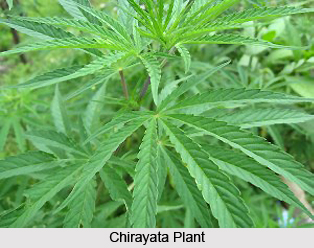 Chirayata, also known as `Indian gentian`, is a healthy, yearly herb, growing approximately upto 1.5 meters in height. It has leaves in diametrical pairs, nearly 10 cm long, without stalks, sharpened at the tip. The plant bears plenty of flowers, pale green in colour, tincted with purple, with long white or pink hairs and minuscule sharply pointed fruits. The entire plant, plucked in its blooming stage and dried, makes up the drug. The trade name `chirayata` is based on the local name of the plant. It has long been in use by the Ayurvedic physicians as an acrid vitaliser.
Chirayata, also known as `Indian gentian`, is a healthy, yearly herb, growing approximately upto 1.5 meters in height. It has leaves in diametrical pairs, nearly 10 cm long, without stalks, sharpened at the tip. The plant bears plenty of flowers, pale green in colour, tincted with purple, with long white or pink hairs and minuscule sharply pointed fruits. The entire plant, plucked in its blooming stage and dried, makes up the drug. The trade name `chirayata` is based on the local name of the plant. It has long been in use by the Ayurvedic physicians as an acrid vitaliser.
The plant contains a sour glycoside chiratin, which generates two bitter principles- ophelic acid and chiratin after hydrolysis. The second is a water-soluble compound. The ophelic acid is a brown hydroscopic substance, soluble in water and alcohol. It also comprises resin, tannin and 4 to 8 % of ash.
Methods of usage
Chirayata, with its immense revitalising effects, heals fever, disturbed nutrition, stomach upsets, intestinal worms, frailty and arrests hiccups.
Healing Power and Medicinal Properties of chirayata
Chirayata is a worthy, sour revitaliser. It is purgative and an appetiser. It also disciplines the troubled process of nutrition and reinstates the customary function of the system.
Fevers cured by chirayata
Chirayata is an effective drug for diminishing feverish symptoms. It is especially advantageous for remedying malarial fevers. It is also efficient in hysteric states and paroxysms.
Stomach Disorders healed by chirayata
The herb is a brilliant drug for reinforcing the stomach and boosting its function. It is used in the treatment of dyspepsia and diarrhoea.
Intestinal Worms healed by chirayata
Chirayata possesses anthelmintic, i.e., worm-destroying properties and is used in obliterating intestinal worms. An infusion of the herb is administered in such cases.
General Debility cured by chirayata
It serves as an efficient vitaliser in case of general exhaustion and during recuperation. The extraction of the plant can be taken in dosages of 60 ml or 4 tablespoons twice daily, prior to meals.
Preparation and Doses - The herb is used in the form of an infusion or tincture. The extraction is made in hot water with aromatics like cloves and cinnamon. It is largely taken in dosages of 15 to 30 ml or 1 to 2 tablespoons.
Other Uses of chirayata
Hiccups - The root of the plant is useful in arresting hiccups and nausea. It is consumed in dosages of 0.5 to 2 grams, together with honey.



















